Global Business Environment: A Report on SASOL's Operations
VerifiedAdded on 2023/01/23
|15
|4780
|77
Report
AI Summary
This report provides a comprehensive analysis of SASOL Limited within the context of the global business environment. It begins with an introduction to globalization, its driving factors, and the impact of digital technology. The report then applies a PESTLE analysis to assess the political, economic, social, technological, legal, and environmental factors influencing SASOL's operations. It also examines the challenges of globalization, including job mobility and cultural impact, and offers recommendations to mitigate these challenges. Furthermore, the report utilizes the McKinsey 7S model and Hofstede's cultural dimensions to evaluate the organization's structure, governance, and cultural influences. Ethical and sustainable factors within the global market, decision-making processes, and strategic expansion routes are also discussed, providing a detailed overview of SASOL's global business strategy and its implications. The report concludes with a summary of findings and references.
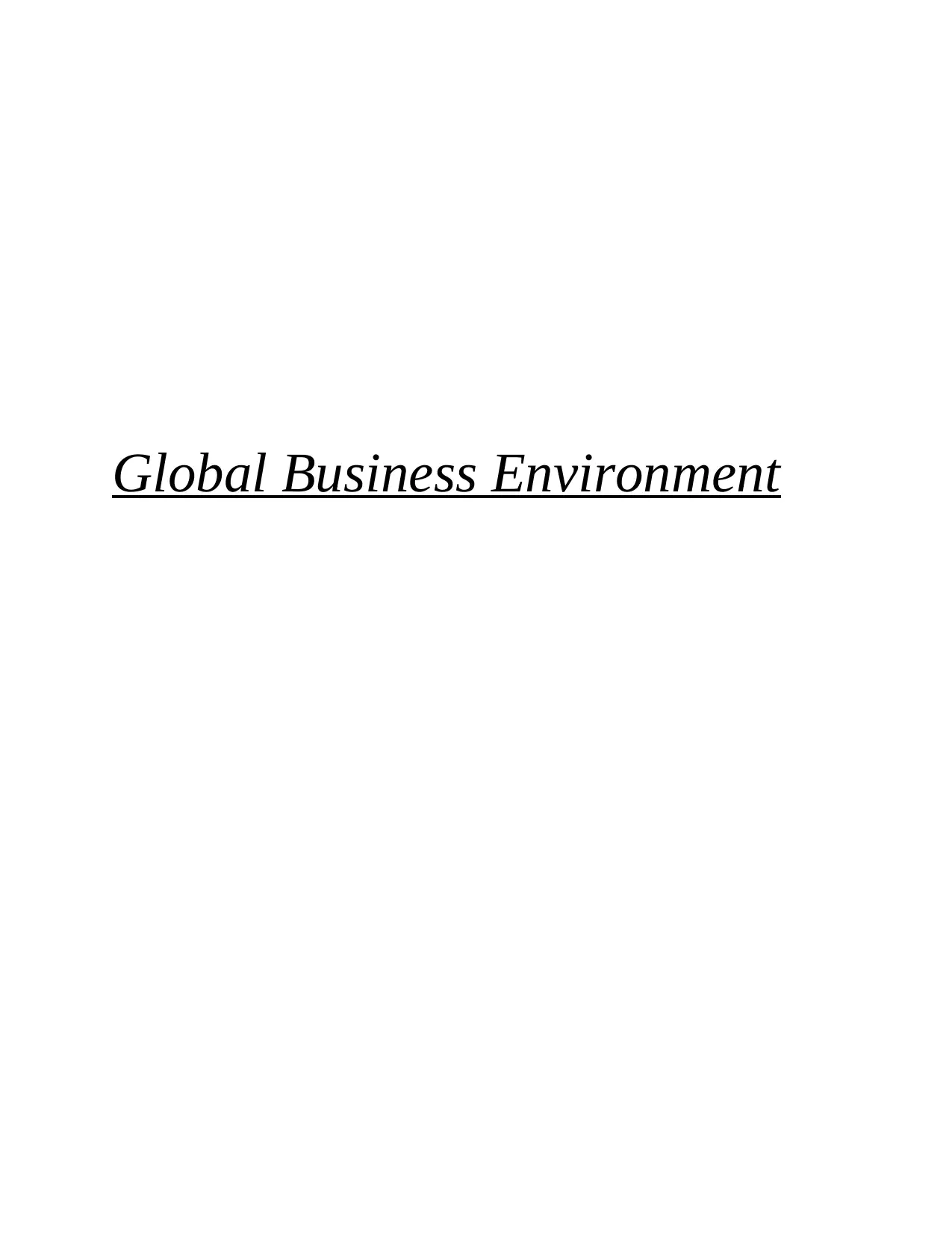
Global Business Environment
Paraphrase This Document
Need a fresh take? Get an instant paraphrase of this document with our AI Paraphraser
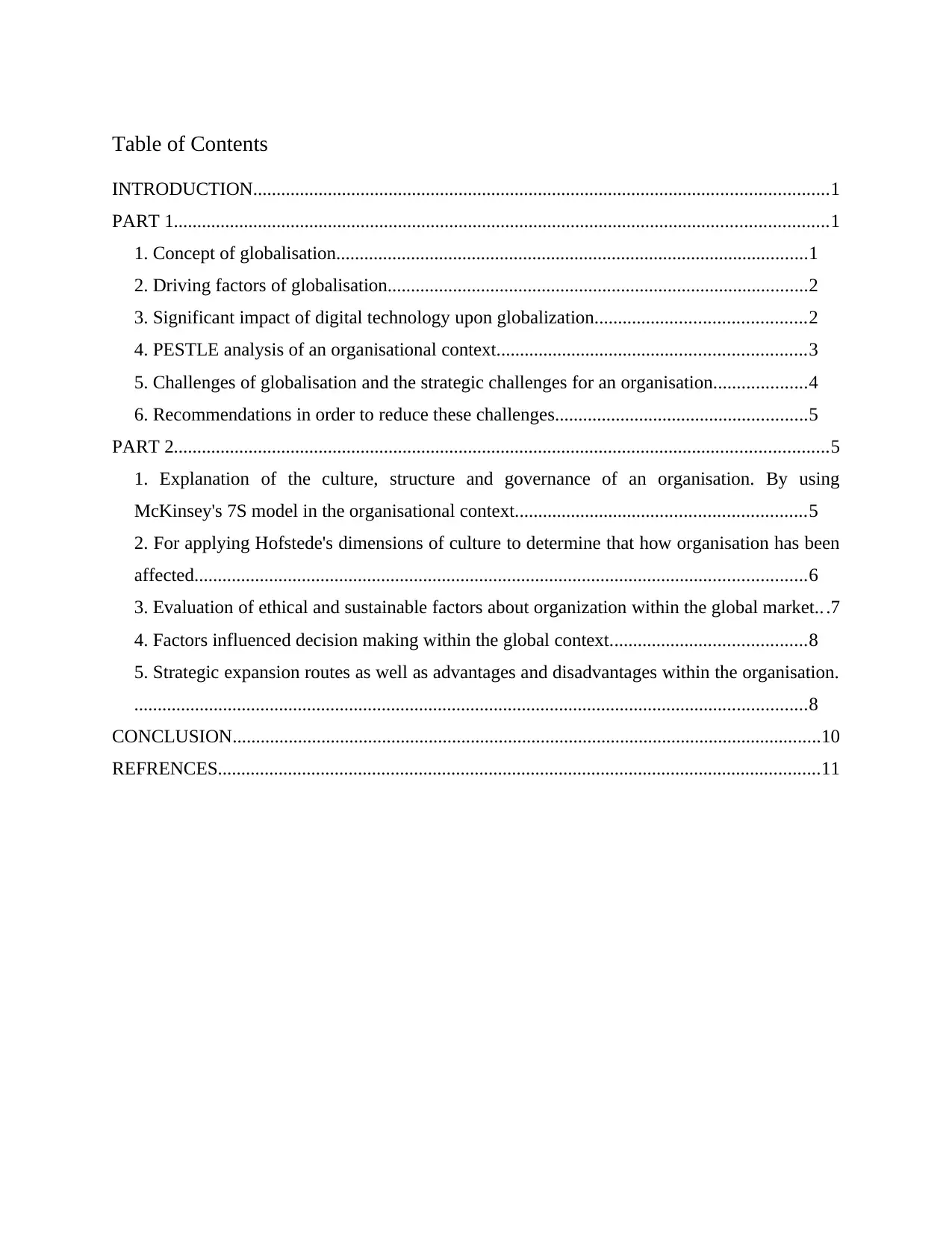
Table of Contents
INTRODUCTION...........................................................................................................................1
PART 1............................................................................................................................................1
1. Concept of globalisation.....................................................................................................1
2. Driving factors of globalisation..........................................................................................2
3. Significant impact of digital technology upon globalization.............................................2
4. PESTLE analysis of an organisational context..................................................................3
5. Challenges of globalisation and the strategic challenges for an organisation....................4
6. Recommendations in order to reduce these challenges......................................................5
PART 2............................................................................................................................................5
1. Explanation of the culture, structure and governance of an organisation. By using
McKinsey's 7S model in the organisational context..............................................................5
2. For applying Hofstede's dimensions of culture to determine that how organisation has been
affected...................................................................................................................................6
3. Evaluation of ethical and sustainable factors about organization within the global market.. .7
4. Factors influenced decision making within the global context..........................................8
5. Strategic expansion routes as well as advantages and disadvantages within the organisation.
................................................................................................................................................8
CONCLUSION..............................................................................................................................10
REFRENCES.................................................................................................................................11
INTRODUCTION...........................................................................................................................1
PART 1............................................................................................................................................1
1. Concept of globalisation.....................................................................................................1
2. Driving factors of globalisation..........................................................................................2
3. Significant impact of digital technology upon globalization.............................................2
4. PESTLE analysis of an organisational context..................................................................3
5. Challenges of globalisation and the strategic challenges for an organisation....................4
6. Recommendations in order to reduce these challenges......................................................5
PART 2............................................................................................................................................5
1. Explanation of the culture, structure and governance of an organisation. By using
McKinsey's 7S model in the organisational context..............................................................5
2. For applying Hofstede's dimensions of culture to determine that how organisation has been
affected...................................................................................................................................6
3. Evaluation of ethical and sustainable factors about organization within the global market.. .7
4. Factors influenced decision making within the global context..........................................8
5. Strategic expansion routes as well as advantages and disadvantages within the organisation.
................................................................................................................................................8
CONCLUSION..............................................................................................................................10
REFRENCES.................................................................................................................................11
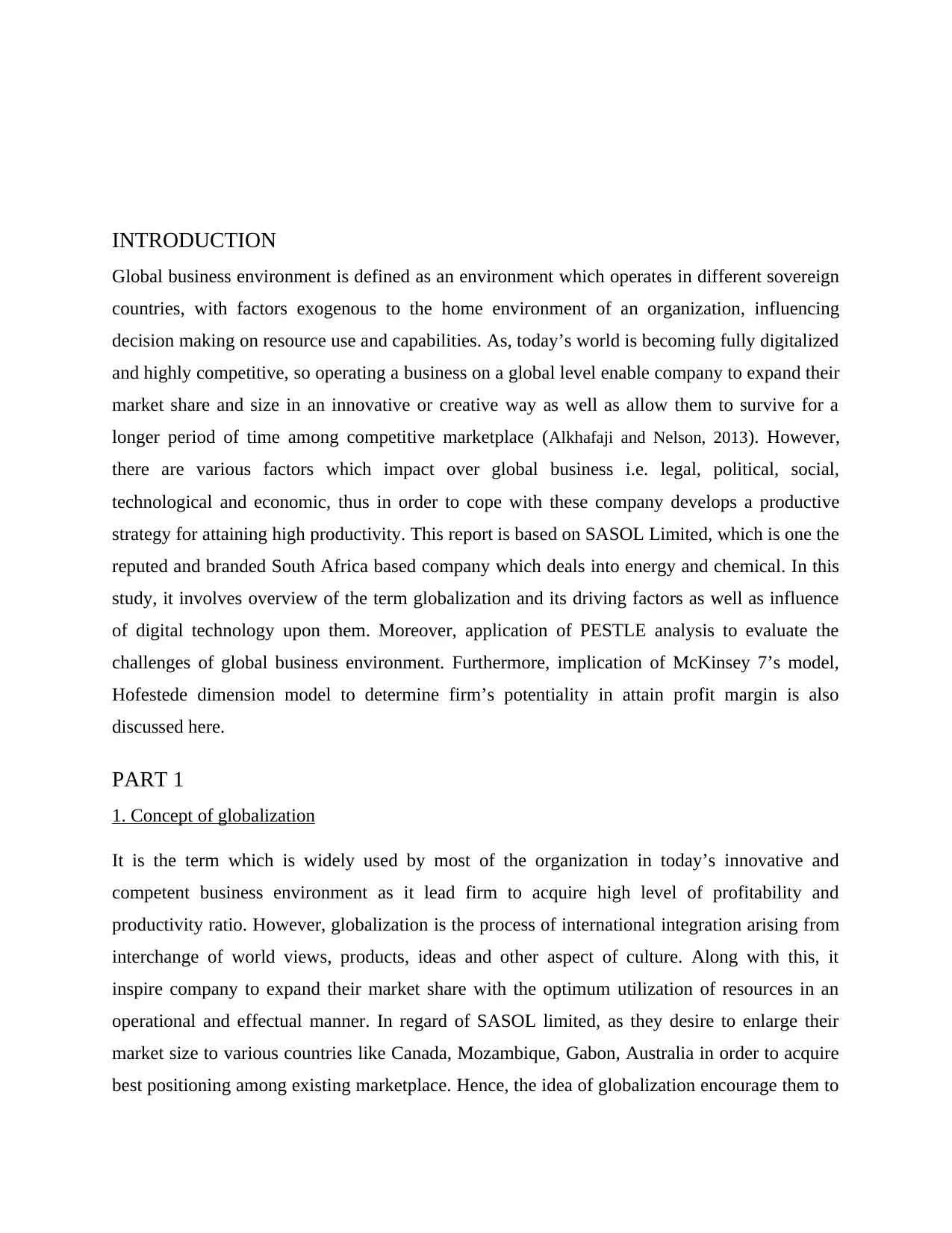
INTRODUCTION
Global business environment is defined as an environment which operates in different sovereign
countries, with factors exogenous to the home environment of an organization, influencing
decision making on resource use and capabilities. As, today’s world is becoming fully digitalized
and highly competitive, so operating a business on a global level enable company to expand their
market share and size in an innovative or creative way as well as allow them to survive for a
longer period of time among competitive marketplace (Alkhafaji and Nelson, 2013). However,
there are various factors which impact over global business i.e. legal, political, social,
technological and economic, thus in order to cope with these company develops a productive
strategy for attaining high productivity. This report is based on SASOL Limited, which is one the
reputed and branded South Africa based company which deals into energy and chemical. In this
study, it involves overview of the term globalization and its driving factors as well as influence
of digital technology upon them. Moreover, application of PESTLE analysis to evaluate the
challenges of global business environment. Furthermore, implication of McKinsey 7’s model,
Hofestede dimension model to determine firm’s potentiality in attain profit margin is also
discussed here.
PART 1
1. Concept of globalization
It is the term which is widely used by most of the organization in today’s innovative and
competent business environment as it lead firm to acquire high level of profitability and
productivity ratio. However, globalization is the process of international integration arising from
interchange of world views, products, ideas and other aspect of culture. Along with this, it
inspire company to expand their market share with the optimum utilization of resources in an
operational and effectual manner. In regard of SASOL limited, as they desire to enlarge their
market size to various countries like Canada, Mozambique, Gabon, Australia in order to acquire
best positioning among existing marketplace. Hence, the idea of globalization encourage them to
Global business environment is defined as an environment which operates in different sovereign
countries, with factors exogenous to the home environment of an organization, influencing
decision making on resource use and capabilities. As, today’s world is becoming fully digitalized
and highly competitive, so operating a business on a global level enable company to expand their
market share and size in an innovative or creative way as well as allow them to survive for a
longer period of time among competitive marketplace (Alkhafaji and Nelson, 2013). However,
there are various factors which impact over global business i.e. legal, political, social,
technological and economic, thus in order to cope with these company develops a productive
strategy for attaining high productivity. This report is based on SASOL Limited, which is one the
reputed and branded South Africa based company which deals into energy and chemical. In this
study, it involves overview of the term globalization and its driving factors as well as influence
of digital technology upon them. Moreover, application of PESTLE analysis to evaluate the
challenges of global business environment. Furthermore, implication of McKinsey 7’s model,
Hofestede dimension model to determine firm’s potentiality in attain profit margin is also
discussed here.
PART 1
1. Concept of globalization
It is the term which is widely used by most of the organization in today’s innovative and
competent business environment as it lead firm to acquire high level of profitability and
productivity ratio. However, globalization is the process of international integration arising from
interchange of world views, products, ideas and other aspect of culture. Along with this, it
inspire company to expand their market share with the optimum utilization of resources in an
operational and effectual manner. In regard of SASOL limited, as they desire to enlarge their
market size to various countries like Canada, Mozambique, Gabon, Australia in order to acquire
best positioning among existing marketplace. Hence, the idea of globalization encourage them to
⊘ This is a preview!⊘
Do you want full access?
Subscribe today to unlock all pages.

Trusted by 1+ million students worldwide
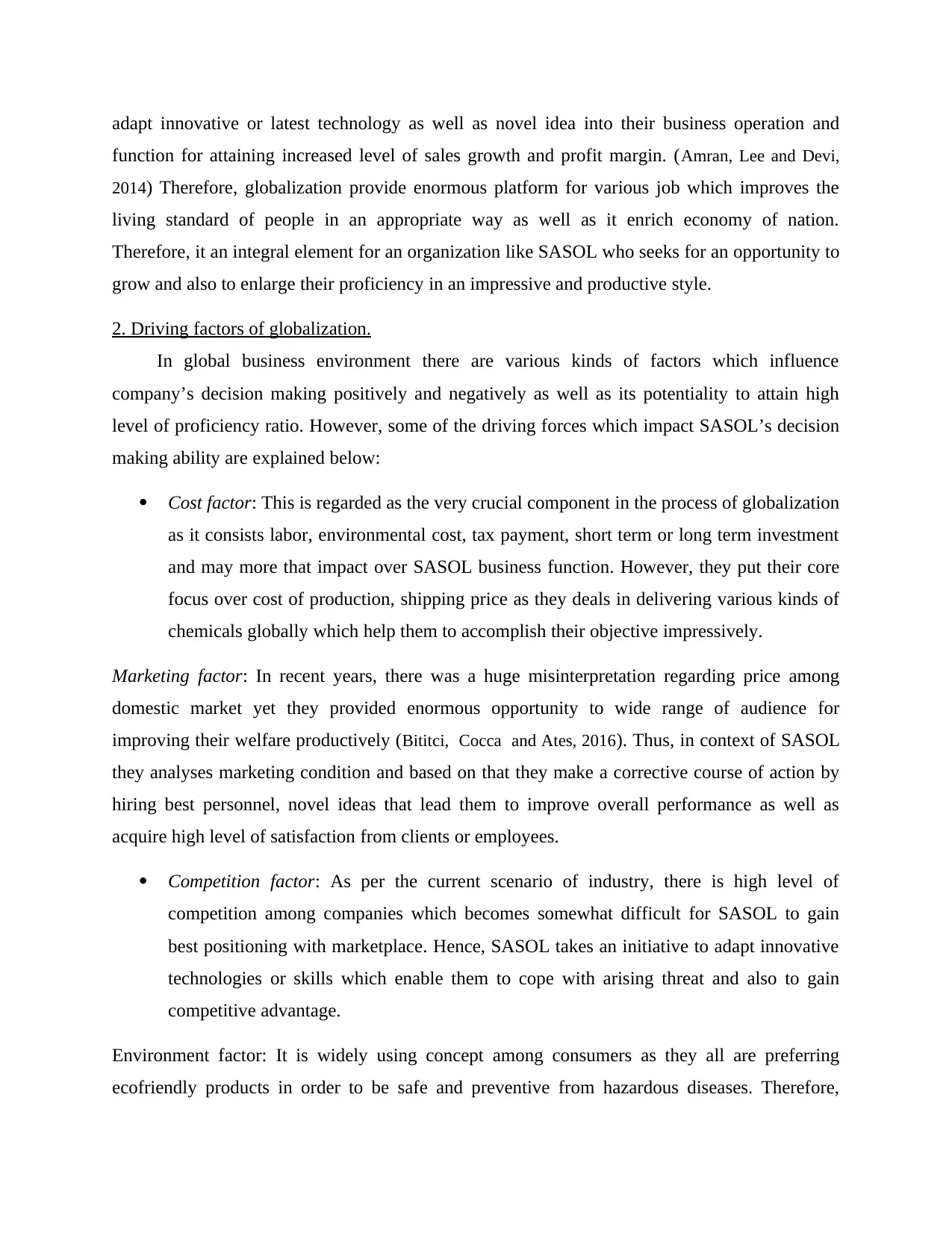
adapt innovative or latest technology as well as novel idea into their business operation and
function for attaining increased level of sales growth and profit margin. (Amran, Lee and Devi,
2014) Therefore, globalization provide enormous platform for various job which improves the
living standard of people in an appropriate way as well as it enrich economy of nation.
Therefore, it an integral element for an organization like SASOL who seeks for an opportunity to
grow and also to enlarge their proficiency in an impressive and productive style.
2. Driving factors of globalization.
In global business environment there are various kinds of factors which influence
company’s decision making positively and negatively as well as its potentiality to attain high
level of proficiency ratio. However, some of the driving forces which impact SASOL’s decision
making ability are explained below:
Cost factor: This is regarded as the very crucial component in the process of globalization
as it consists labor, environmental cost, tax payment, short term or long term investment
and may more that impact over SASOL business function. However, they put their core
focus over cost of production, shipping price as they deals in delivering various kinds of
chemicals globally which help them to accomplish their objective impressively.
Marketing factor: In recent years, there was a huge misinterpretation regarding price among
domestic market yet they provided enormous opportunity to wide range of audience for
improving their welfare productively (Bititci, Cocca and Ates, 2016). Thus, in context of SASOL
they analyses marketing condition and based on that they make a corrective course of action by
hiring best personnel, novel ideas that lead them to improve overall performance as well as
acquire high level of satisfaction from clients or employees.
Competition factor: As per the current scenario of industry, there is high level of
competition among companies which becomes somewhat difficult for SASOL to gain
best positioning with marketplace. Hence, SASOL takes an initiative to adapt innovative
technologies or skills which enable them to cope with arising threat and also to gain
competitive advantage.
Environment factor: It is widely using concept among consumers as they all are preferring
ecofriendly products in order to be safe and preventive from hazardous diseases. Therefore,
function for attaining increased level of sales growth and profit margin. (Amran, Lee and Devi,
2014) Therefore, globalization provide enormous platform for various job which improves the
living standard of people in an appropriate way as well as it enrich economy of nation.
Therefore, it an integral element for an organization like SASOL who seeks for an opportunity to
grow and also to enlarge their proficiency in an impressive and productive style.
2. Driving factors of globalization.
In global business environment there are various kinds of factors which influence
company’s decision making positively and negatively as well as its potentiality to attain high
level of proficiency ratio. However, some of the driving forces which impact SASOL’s decision
making ability are explained below:
Cost factor: This is regarded as the very crucial component in the process of globalization
as it consists labor, environmental cost, tax payment, short term or long term investment
and may more that impact over SASOL business function. However, they put their core
focus over cost of production, shipping price as they deals in delivering various kinds of
chemicals globally which help them to accomplish their objective impressively.
Marketing factor: In recent years, there was a huge misinterpretation regarding price among
domestic market yet they provided enormous opportunity to wide range of audience for
improving their welfare productively (Bititci, Cocca and Ates, 2016). Thus, in context of SASOL
they analyses marketing condition and based on that they make a corrective course of action by
hiring best personnel, novel ideas that lead them to improve overall performance as well as
acquire high level of satisfaction from clients or employees.
Competition factor: As per the current scenario of industry, there is high level of
competition among companies which becomes somewhat difficult for SASOL to gain
best positioning with marketplace. Hence, SASOL takes an initiative to adapt innovative
technologies or skills which enable them to cope with arising threat and also to gain
competitive advantage.
Environment factor: It is widely using concept among consumers as they all are preferring
ecofriendly products in order to be safe and preventive from hazardous diseases. Therefore,
Paraphrase This Document
Need a fresh take? Get an instant paraphrase of this document with our AI Paraphraser
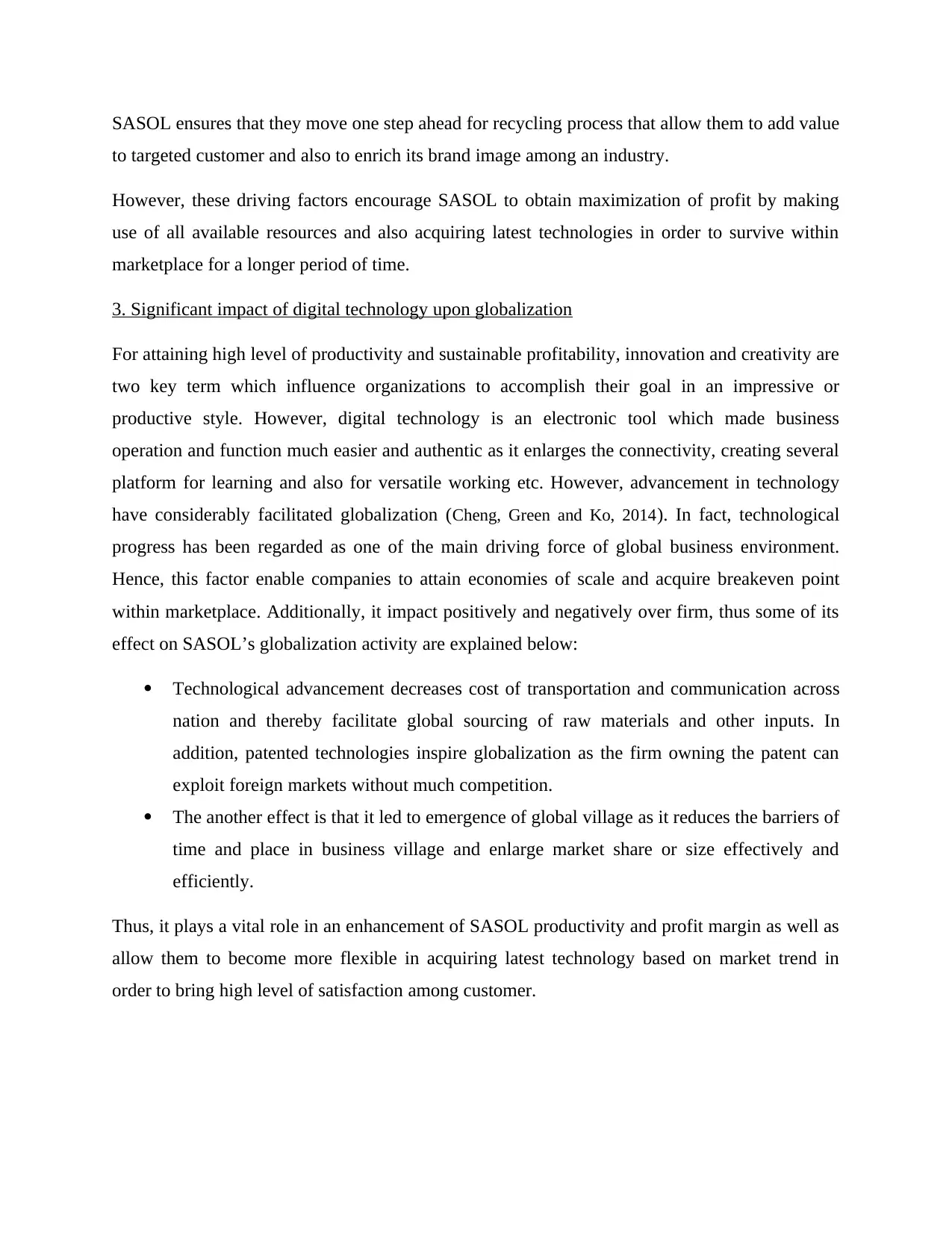
SASOL ensures that they move one step ahead for recycling process that allow them to add value
to targeted customer and also to enrich its brand image among an industry.
However, these driving factors encourage SASOL to obtain maximization of profit by making
use of all available resources and also acquiring latest technologies in order to survive within
marketplace for a longer period of time.
3. Significant impact of digital technology upon globalization
For attaining high level of productivity and sustainable profitability, innovation and creativity are
two key term which influence organizations to accomplish their goal in an impressive or
productive style. However, digital technology is an electronic tool which made business
operation and function much easier and authentic as it enlarges the connectivity, creating several
platform for learning and also for versatile working etc. However, advancement in technology
have considerably facilitated globalization (Cheng, Green and Ko, 2014). In fact, technological
progress has been regarded as one of the main driving force of global business environment.
Hence, this factor enable companies to attain economies of scale and acquire breakeven point
within marketplace. Additionally, it impact positively and negatively over firm, thus some of its
effect on SASOL’s globalization activity are explained below:
Technological advancement decreases cost of transportation and communication across
nation and thereby facilitate global sourcing of raw materials and other inputs. In
addition, patented technologies inspire globalization as the firm owning the patent can
exploit foreign markets without much competition.
The another effect is that it led to emergence of global village as it reduces the barriers of
time and place in business village and enlarge market share or size effectively and
efficiently.
Thus, it plays a vital role in an enhancement of SASOL productivity and profit margin as well as
allow them to become more flexible in acquiring latest technology based on market trend in
order to bring high level of satisfaction among customer.
to targeted customer and also to enrich its brand image among an industry.
However, these driving factors encourage SASOL to obtain maximization of profit by making
use of all available resources and also acquiring latest technologies in order to survive within
marketplace for a longer period of time.
3. Significant impact of digital technology upon globalization
For attaining high level of productivity and sustainable profitability, innovation and creativity are
two key term which influence organizations to accomplish their goal in an impressive or
productive style. However, digital technology is an electronic tool which made business
operation and function much easier and authentic as it enlarges the connectivity, creating several
platform for learning and also for versatile working etc. However, advancement in technology
have considerably facilitated globalization (Cheng, Green and Ko, 2014). In fact, technological
progress has been regarded as one of the main driving force of global business environment.
Hence, this factor enable companies to attain economies of scale and acquire breakeven point
within marketplace. Additionally, it impact positively and negatively over firm, thus some of its
effect on SASOL’s globalization activity are explained below:
Technological advancement decreases cost of transportation and communication across
nation and thereby facilitate global sourcing of raw materials and other inputs. In
addition, patented technologies inspire globalization as the firm owning the patent can
exploit foreign markets without much competition.
The another effect is that it led to emergence of global village as it reduces the barriers of
time and place in business village and enlarge market share or size effectively and
efficiently.
Thus, it plays a vital role in an enhancement of SASOL productivity and profit margin as well as
allow them to become more flexible in acquiring latest technology based on market trend in
order to bring high level of satisfaction among customer.
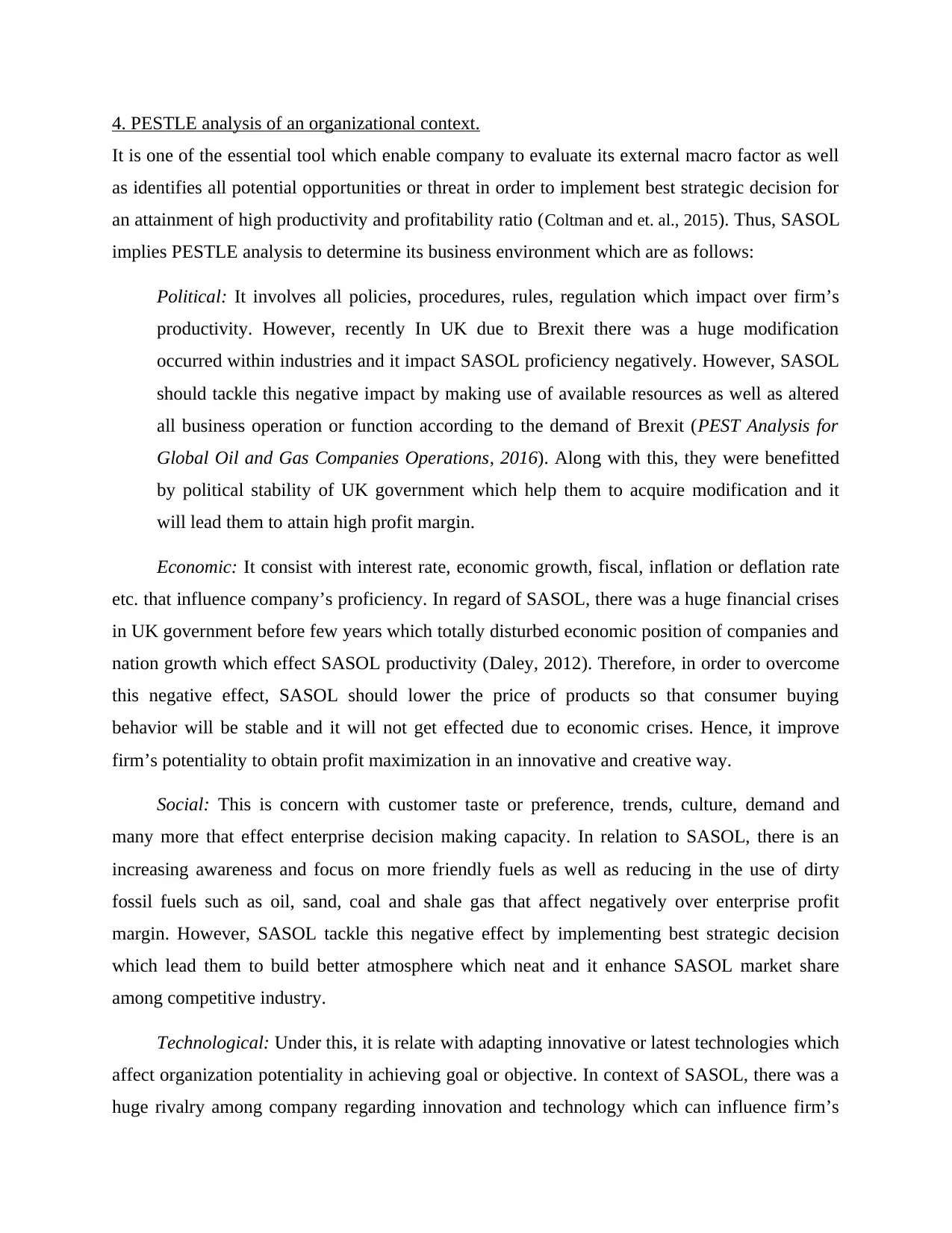
4. PESTLE analysis of an organizational context.
It is one of the essential tool which enable company to evaluate its external macro factor as well
as identifies all potential opportunities or threat in order to implement best strategic decision for
an attainment of high productivity and profitability ratio (Coltman and et. al., 2015). Thus, SASOL
implies PESTLE analysis to determine its business environment which are as follows:
Political: It involves all policies, procedures, rules, regulation which impact over firm’s
productivity. However, recently In UK due to Brexit there was a huge modification
occurred within industries and it impact SASOL proficiency negatively. However, SASOL
should tackle this negative impact by making use of available resources as well as altered
all business operation or function according to the demand of Brexit (PEST Analysis for
Global Oil and Gas Companies Operations, 2016). Along with this, they were benefitted
by political stability of UK government which help them to acquire modification and it
will lead them to attain high profit margin.
Economic: It consist with interest rate, economic growth, fiscal, inflation or deflation rate
etc. that influence company’s proficiency. In regard of SASOL, there was a huge financial crises
in UK government before few years which totally disturbed economic position of companies and
nation growth which effect SASOL productivity (Daley, 2012). Therefore, in order to overcome
this negative effect, SASOL should lower the price of products so that consumer buying
behavior will be stable and it will not get effected due to economic crises. Hence, it improve
firm’s potentiality to obtain profit maximization in an innovative and creative way.
Social: This is concern with customer taste or preference, trends, culture, demand and
many more that effect enterprise decision making capacity. In relation to SASOL, there is an
increasing awareness and focus on more friendly fuels as well as reducing in the use of dirty
fossil fuels such as oil, sand, coal and shale gas that affect negatively over enterprise profit
margin. However, SASOL tackle this negative effect by implementing best strategic decision
which lead them to build better atmosphere which neat and it enhance SASOL market share
among competitive industry.
Technological: Under this, it is relate with adapting innovative or latest technologies which
affect organization potentiality in achieving goal or objective. In context of SASOL, there was a
huge rivalry among company regarding innovation and technology which can influence firm’s
It is one of the essential tool which enable company to evaluate its external macro factor as well
as identifies all potential opportunities or threat in order to implement best strategic decision for
an attainment of high productivity and profitability ratio (Coltman and et. al., 2015). Thus, SASOL
implies PESTLE analysis to determine its business environment which are as follows:
Political: It involves all policies, procedures, rules, regulation which impact over firm’s
productivity. However, recently In UK due to Brexit there was a huge modification
occurred within industries and it impact SASOL proficiency negatively. However, SASOL
should tackle this negative impact by making use of available resources as well as altered
all business operation or function according to the demand of Brexit (PEST Analysis for
Global Oil and Gas Companies Operations, 2016). Along with this, they were benefitted
by political stability of UK government which help them to acquire modification and it
will lead them to attain high profit margin.
Economic: It consist with interest rate, economic growth, fiscal, inflation or deflation rate
etc. that influence company’s proficiency. In regard of SASOL, there was a huge financial crises
in UK government before few years which totally disturbed economic position of companies and
nation growth which effect SASOL productivity (Daley, 2012). Therefore, in order to overcome
this negative effect, SASOL should lower the price of products so that consumer buying
behavior will be stable and it will not get effected due to economic crises. Hence, it improve
firm’s potentiality to obtain profit maximization in an innovative and creative way.
Social: This is concern with customer taste or preference, trends, culture, demand and
many more that effect enterprise decision making capacity. In relation to SASOL, there is an
increasing awareness and focus on more friendly fuels as well as reducing in the use of dirty
fossil fuels such as oil, sand, coal and shale gas that affect negatively over enterprise profit
margin. However, SASOL tackle this negative effect by implementing best strategic decision
which lead them to build better atmosphere which neat and it enhance SASOL market share
among competitive industry.
Technological: Under this, it is relate with adapting innovative or latest technologies which
affect organization potentiality in achieving goal or objective. In context of SASOL, there was a
huge rivalry among company regarding innovation and technology which can influence firm’s
⊘ This is a preview!⊘
Do you want full access?
Subscribe today to unlock all pages.

Trusted by 1+ million students worldwide
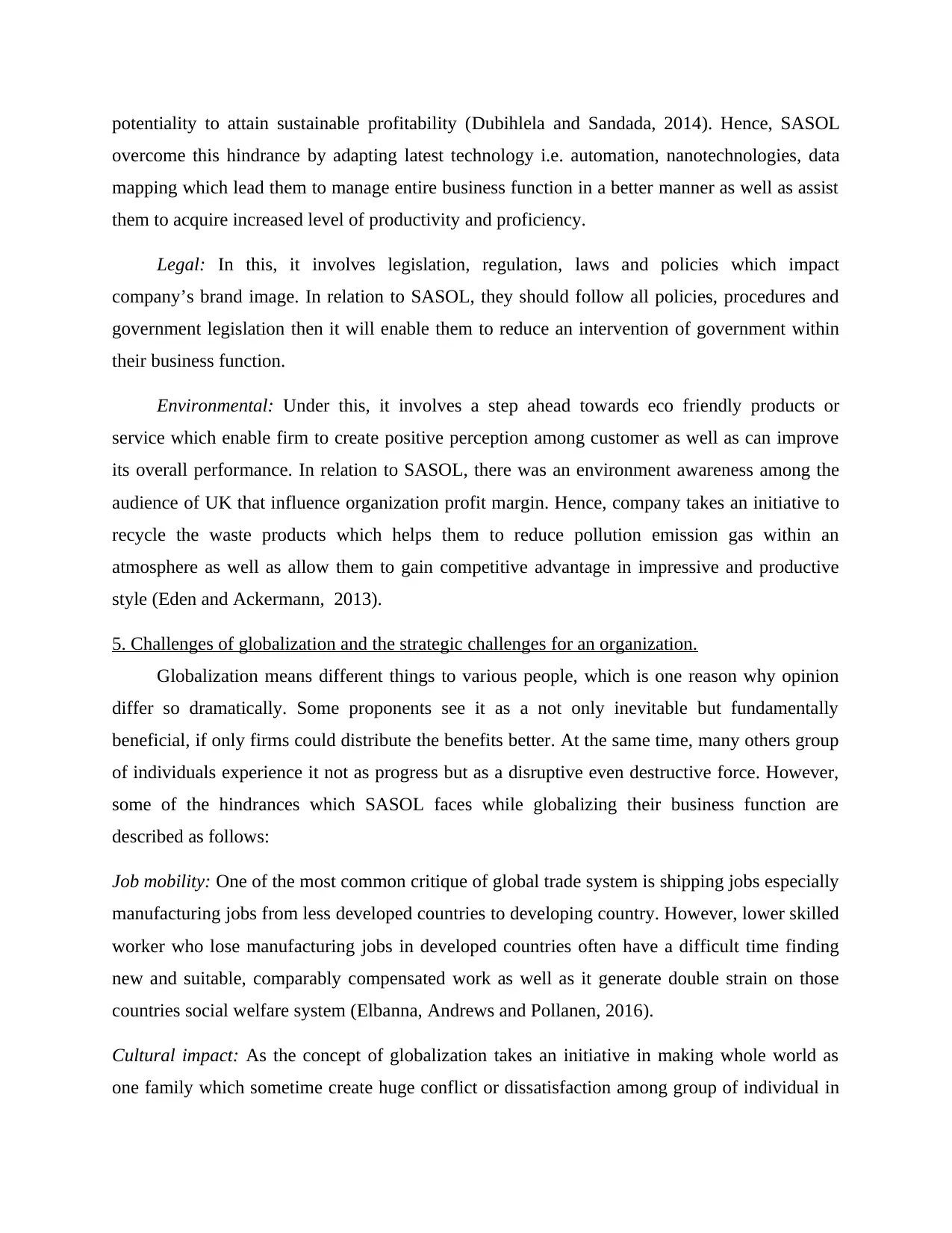
potentiality to attain sustainable profitability (Dubihlela and Sandada, 2014). Hence, SASOL
overcome this hindrance by adapting latest technology i.e. automation, nanotechnologies, data
mapping which lead them to manage entire business function in a better manner as well as assist
them to acquire increased level of productivity and proficiency.
Legal: In this, it involves legislation, regulation, laws and policies which impact
company’s brand image. In relation to SASOL, they should follow all policies, procedures and
government legislation then it will enable them to reduce an intervention of government within
their business function.
Environmental: Under this, it involves a step ahead towards eco friendly products or
service which enable firm to create positive perception among customer as well as can improve
its overall performance. In relation to SASOL, there was an environment awareness among the
audience of UK that influence organization profit margin. Hence, company takes an initiative to
recycle the waste products which helps them to reduce pollution emission gas within an
atmosphere as well as allow them to gain competitive advantage in impressive and productive
style (Eden and Ackermann, 2013).
5. Challenges of globalization and the strategic challenges for an organization.
Globalization means different things to various people, which is one reason why opinion
differ so dramatically. Some proponents see it as a not only inevitable but fundamentally
beneficial, if only firms could distribute the benefits better. At the same time, many others group
of individuals experience it not as progress but as a disruptive even destructive force. However,
some of the hindrances which SASOL faces while globalizing their business function are
described as follows:
Job mobility: One of the most common critique of global trade system is shipping jobs especially
manufacturing jobs from less developed countries to developing country. However, lower skilled
worker who lose manufacturing jobs in developed countries often have a difficult time finding
new and suitable, comparably compensated work as well as it generate double strain on those
countries social welfare system (Elbanna, Andrews and Pollanen, 2016).
Cultural impact: As the concept of globalization takes an initiative in making whole world as
one family which sometime create huge conflict or dissatisfaction among group of individual in
overcome this hindrance by adapting latest technology i.e. automation, nanotechnologies, data
mapping which lead them to manage entire business function in a better manner as well as assist
them to acquire increased level of productivity and proficiency.
Legal: In this, it involves legislation, regulation, laws and policies which impact
company’s brand image. In relation to SASOL, they should follow all policies, procedures and
government legislation then it will enable them to reduce an intervention of government within
their business function.
Environmental: Under this, it involves a step ahead towards eco friendly products or
service which enable firm to create positive perception among customer as well as can improve
its overall performance. In relation to SASOL, there was an environment awareness among the
audience of UK that influence organization profit margin. Hence, company takes an initiative to
recycle the waste products which helps them to reduce pollution emission gas within an
atmosphere as well as allow them to gain competitive advantage in impressive and productive
style (Eden and Ackermann, 2013).
5. Challenges of globalization and the strategic challenges for an organization.
Globalization means different things to various people, which is one reason why opinion
differ so dramatically. Some proponents see it as a not only inevitable but fundamentally
beneficial, if only firms could distribute the benefits better. At the same time, many others group
of individuals experience it not as progress but as a disruptive even destructive force. However,
some of the hindrances which SASOL faces while globalizing their business function are
described as follows:
Job mobility: One of the most common critique of global trade system is shipping jobs especially
manufacturing jobs from less developed countries to developing country. However, lower skilled
worker who lose manufacturing jobs in developed countries often have a difficult time finding
new and suitable, comparably compensated work as well as it generate double strain on those
countries social welfare system (Elbanna, Andrews and Pollanen, 2016).
Cultural impact: As the concept of globalization takes an initiative in making whole world as
one family which sometime create huge conflict or dissatisfaction among group of individual in
Paraphrase This Document
Need a fresh take? Get an instant paraphrase of this document with our AI Paraphraser
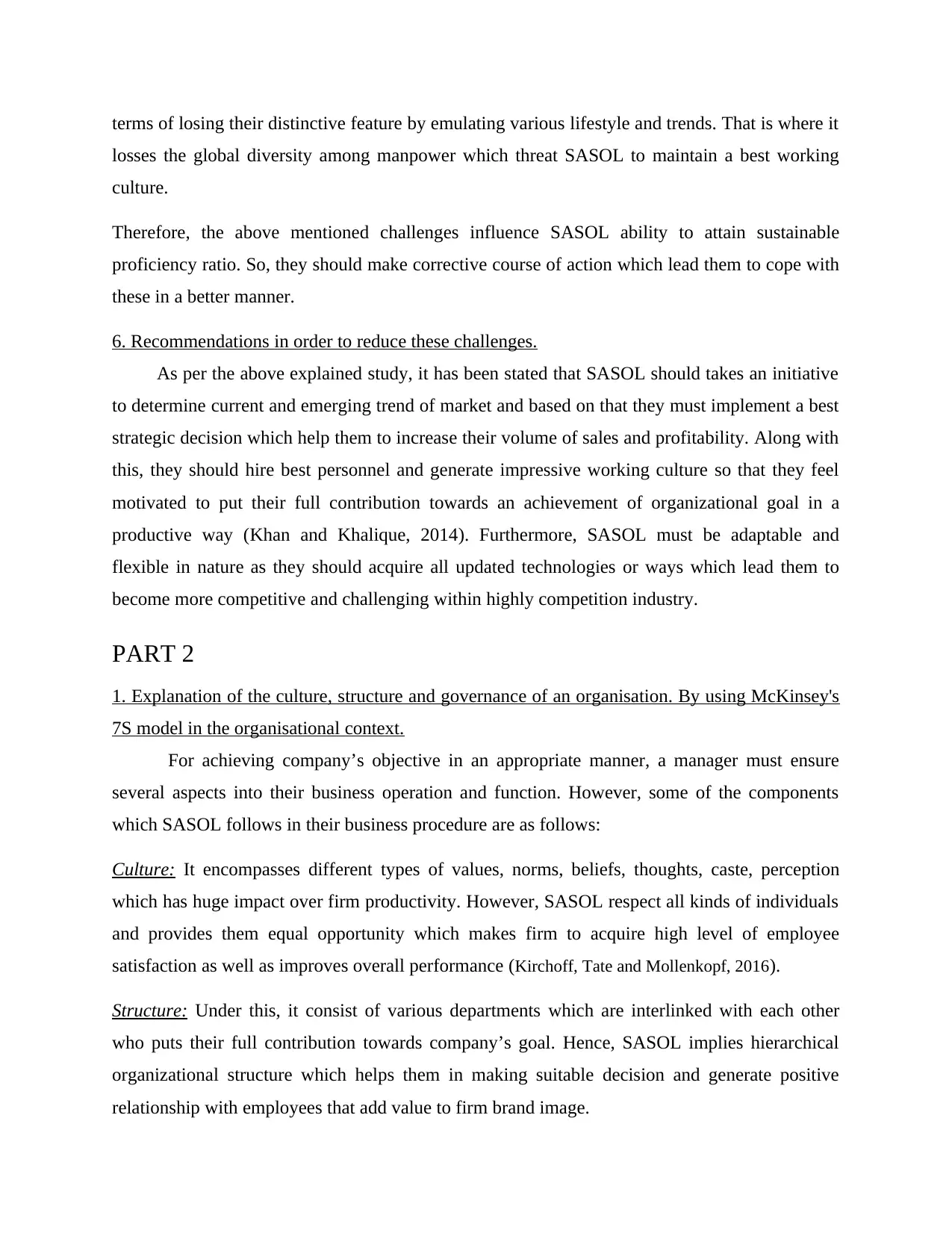
terms of losing their distinctive feature by emulating various lifestyle and trends. That is where it
losses the global diversity among manpower which threat SASOL to maintain a best working
culture.
Therefore, the above mentioned challenges influence SASOL ability to attain sustainable
proficiency ratio. So, they should make corrective course of action which lead them to cope with
these in a better manner.
6. Recommendations in order to reduce these challenges.
As per the above explained study, it has been stated that SASOL should takes an initiative
to determine current and emerging trend of market and based on that they must implement a best
strategic decision which help them to increase their volume of sales and profitability. Along with
this, they should hire best personnel and generate impressive working culture so that they feel
motivated to put their full contribution towards an achievement of organizational goal in a
productive way (Khan and Khalique, 2014). Furthermore, SASOL must be adaptable and
flexible in nature as they should acquire all updated technologies or ways which lead them to
become more competitive and challenging within highly competition industry.
PART 2
1. Explanation of the culture, structure and governance of an organisation. By using McKinsey's
7S model in the organisational context.
For achieving company’s objective in an appropriate manner, a manager must ensure
several aspects into their business operation and function. However, some of the components
which SASOL follows in their business procedure are as follows:
Culture: It encompasses different types of values, norms, beliefs, thoughts, caste, perception
which has huge impact over firm productivity. However, SASOL respect all kinds of individuals
and provides them equal opportunity which makes firm to acquire high level of employee
satisfaction as well as improves overall performance (Kirchoff, Tate and Mollenkopf, 2016).
Structure: Under this, it consist of various departments which are interlinked with each other
who puts their full contribution towards company’s goal. Hence, SASOL implies hierarchical
organizational structure which helps them in making suitable decision and generate positive
relationship with employees that add value to firm brand image.
losses the global diversity among manpower which threat SASOL to maintain a best working
culture.
Therefore, the above mentioned challenges influence SASOL ability to attain sustainable
proficiency ratio. So, they should make corrective course of action which lead them to cope with
these in a better manner.
6. Recommendations in order to reduce these challenges.
As per the above explained study, it has been stated that SASOL should takes an initiative
to determine current and emerging trend of market and based on that they must implement a best
strategic decision which help them to increase their volume of sales and profitability. Along with
this, they should hire best personnel and generate impressive working culture so that they feel
motivated to put their full contribution towards an achievement of organizational goal in a
productive way (Khan and Khalique, 2014). Furthermore, SASOL must be adaptable and
flexible in nature as they should acquire all updated technologies or ways which lead them to
become more competitive and challenging within highly competition industry.
PART 2
1. Explanation of the culture, structure and governance of an organisation. By using McKinsey's
7S model in the organisational context.
For achieving company’s objective in an appropriate manner, a manager must ensure
several aspects into their business operation and function. However, some of the components
which SASOL follows in their business procedure are as follows:
Culture: It encompasses different types of values, norms, beliefs, thoughts, caste, perception
which has huge impact over firm productivity. However, SASOL respect all kinds of individuals
and provides them equal opportunity which makes firm to acquire high level of employee
satisfaction as well as improves overall performance (Kirchoff, Tate and Mollenkopf, 2016).
Structure: Under this, it consist of various departments which are interlinked with each other
who puts their full contribution towards company’s goal. Hence, SASOL implies hierarchical
organizational structure which helps them in making suitable decision and generate positive
relationship with employees that add value to firm brand image.
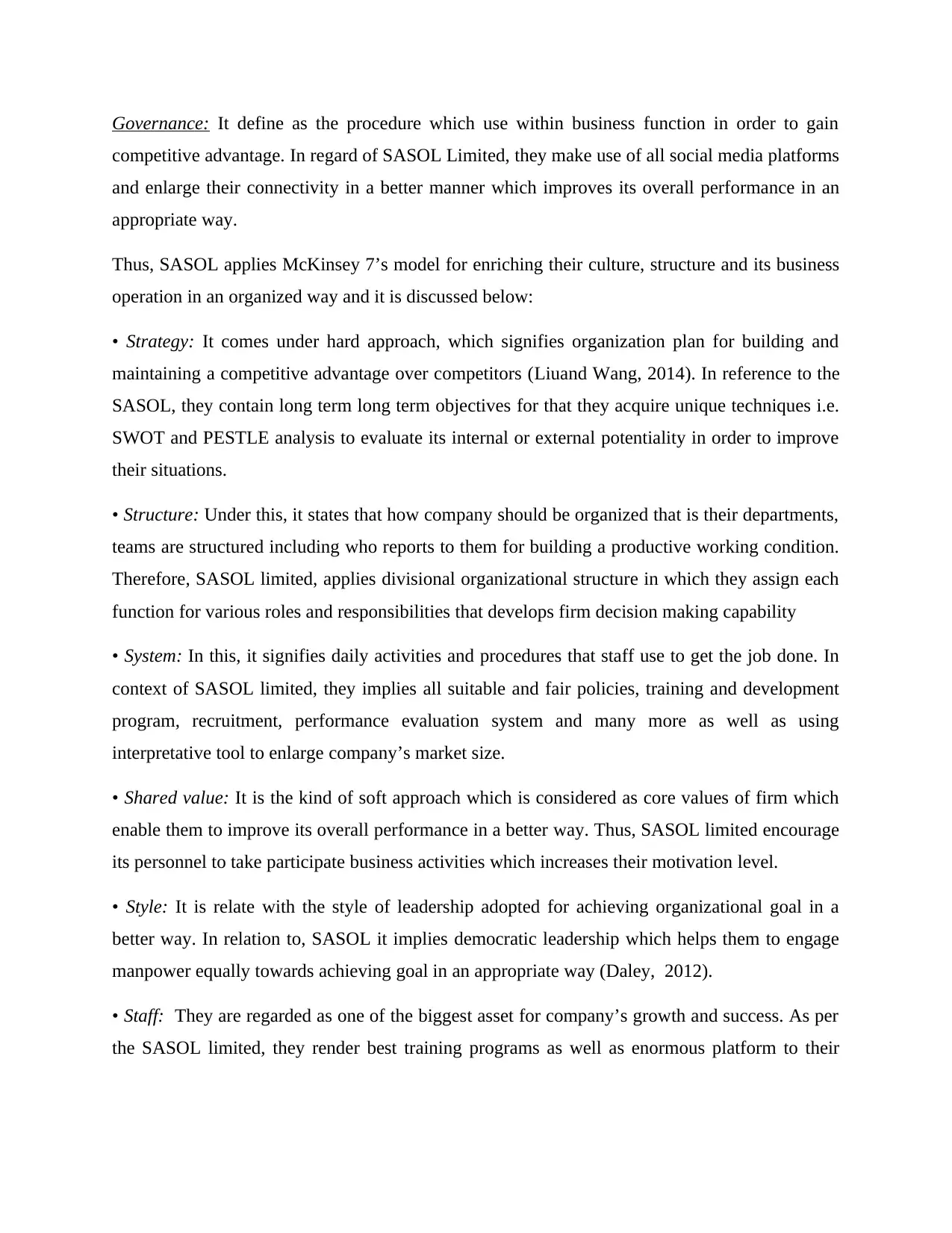
Governance: It define as the procedure which use within business function in order to gain
competitive advantage. In regard of SASOL Limited, they make use of all social media platforms
and enlarge their connectivity in a better manner which improves its overall performance in an
appropriate way.
Thus, SASOL applies McKinsey 7’s model for enriching their culture, structure and its business
operation in an organized way and it is discussed below:
• Strategy: It comes under hard approach, which signifies organization plan for building and
maintaining a competitive advantage over competitors (Liuand Wang, 2014). In reference to the
SASOL, they contain long term long term objectives for that they acquire unique techniques i.e.
SWOT and PESTLE analysis to evaluate its internal or external potentiality in order to improve
their situations.
• Structure: Under this, it states that how company should be organized that is their departments,
teams are structured including who reports to them for building a productive working condition.
Therefore, SASOL limited, applies divisional organizational structure in which they assign each
function for various roles and responsibilities that develops firm decision making capability
• System: In this, it signifies daily activities and procedures that staff use to get the job done. In
context of SASOL limited, they implies all suitable and fair policies, training and development
program, recruitment, performance evaluation system and many more as well as using
interpretative tool to enlarge company’s market size.
• Shared value: It is the kind of soft approach which is considered as core values of firm which
enable them to improve its overall performance in a better way. Thus, SASOL limited encourage
its personnel to take participate business activities which increases their motivation level.
• Style: It is relate with the style of leadership adopted for achieving organizational goal in a
better way. In relation to, SASOL it implies democratic leadership which helps them to engage
manpower equally towards achieving goal in an appropriate way (Daley, 2012).
• Staff: They are regarded as one of the biggest asset for company’s growth and success. As per
the SASOL limited, they render best training programs as well as enormous platform to their
competitive advantage. In regard of SASOL Limited, they make use of all social media platforms
and enlarge their connectivity in a better manner which improves its overall performance in an
appropriate way.
Thus, SASOL applies McKinsey 7’s model for enriching their culture, structure and its business
operation in an organized way and it is discussed below:
• Strategy: It comes under hard approach, which signifies organization plan for building and
maintaining a competitive advantage over competitors (Liuand Wang, 2014). In reference to the
SASOL, they contain long term long term objectives for that they acquire unique techniques i.e.
SWOT and PESTLE analysis to evaluate its internal or external potentiality in order to improve
their situations.
• Structure: Under this, it states that how company should be organized that is their departments,
teams are structured including who reports to them for building a productive working condition.
Therefore, SASOL limited, applies divisional organizational structure in which they assign each
function for various roles and responsibilities that develops firm decision making capability
• System: In this, it signifies daily activities and procedures that staff use to get the job done. In
context of SASOL limited, they implies all suitable and fair policies, training and development
program, recruitment, performance evaluation system and many more as well as using
interpretative tool to enlarge company’s market size.
• Shared value: It is the kind of soft approach which is considered as core values of firm which
enable them to improve its overall performance in a better way. Thus, SASOL limited encourage
its personnel to take participate business activities which increases their motivation level.
• Style: It is relate with the style of leadership adopted for achieving organizational goal in a
better way. In relation to, SASOL it implies democratic leadership which helps them to engage
manpower equally towards achieving goal in an appropriate way (Daley, 2012).
• Staff: They are regarded as one of the biggest asset for company’s growth and success. As per
the SASOL limited, they render best training programs as well as enormous platform to their
⊘ This is a preview!⊘
Do you want full access?
Subscribe today to unlock all pages.

Trusted by 1+ million students worldwide
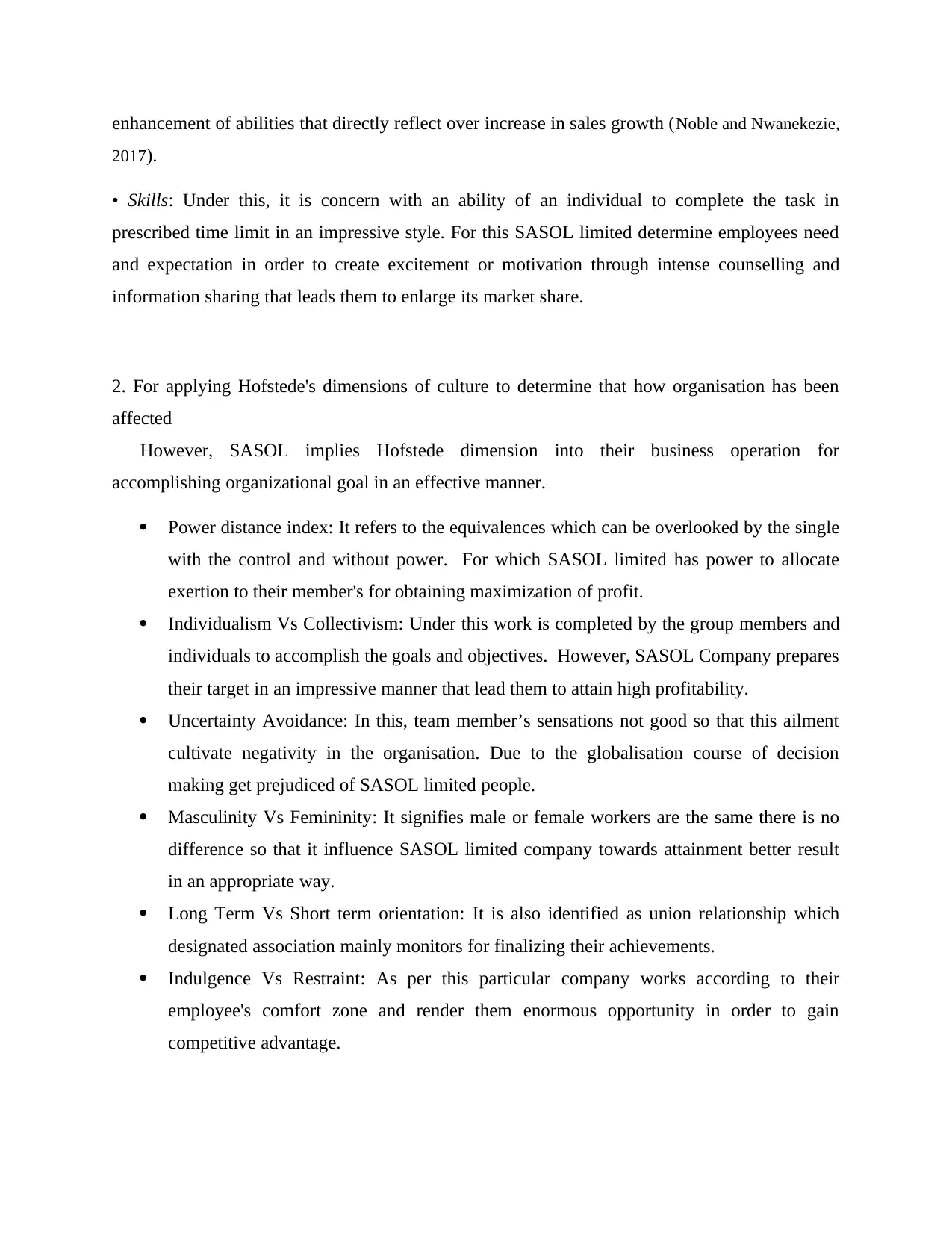
enhancement of abilities that directly reflect over increase in sales growth (Noble and Nwanekezie,
2017).
• Skills: Under this, it is concern with an ability of an individual to complete the task in
prescribed time limit in an impressive style. For this SASOL limited determine employees need
and expectation in order to create excitement or motivation through intense counselling and
information sharing that leads them to enlarge its market share.
2. For applying Hofstede's dimensions of culture to determine that how organisation has been
affected
However, SASOL implies Hofstede dimension into their business operation for
accomplishing organizational goal in an effective manner.
Power distance index: It refers to the equivalences which can be overlooked by the single
with the control and without power. For which SASOL limited has power to allocate
exertion to their member's for obtaining maximization of profit.
Individualism Vs Collectivism: Under this work is completed by the group members and
individuals to accomplish the goals and objectives. However, SASOL Company prepares
their target in an impressive manner that lead them to attain high profitability.
Uncertainty Avoidance: In this, team member’s sensations not good so that this ailment
cultivate negativity in the organisation. Due to the globalisation course of decision
making get prejudiced of SASOL limited people.
Masculinity Vs Femininity: It signifies male or female workers are the same there is no
difference so that it influence SASOL limited company towards attainment better result
in an appropriate way.
Long Term Vs Short term orientation: It is also identified as union relationship which
designated association mainly monitors for finalizing their achievements.
Indulgence Vs Restraint: As per this particular company works according to their
employee's comfort zone and render them enormous opportunity in order to gain
competitive advantage.
2017).
• Skills: Under this, it is concern with an ability of an individual to complete the task in
prescribed time limit in an impressive style. For this SASOL limited determine employees need
and expectation in order to create excitement or motivation through intense counselling and
information sharing that leads them to enlarge its market share.
2. For applying Hofstede's dimensions of culture to determine that how organisation has been
affected
However, SASOL implies Hofstede dimension into their business operation for
accomplishing organizational goal in an effective manner.
Power distance index: It refers to the equivalences which can be overlooked by the single
with the control and without power. For which SASOL limited has power to allocate
exertion to their member's for obtaining maximization of profit.
Individualism Vs Collectivism: Under this work is completed by the group members and
individuals to accomplish the goals and objectives. However, SASOL Company prepares
their target in an impressive manner that lead them to attain high profitability.
Uncertainty Avoidance: In this, team member’s sensations not good so that this ailment
cultivate negativity in the organisation. Due to the globalisation course of decision
making get prejudiced of SASOL limited people.
Masculinity Vs Femininity: It signifies male or female workers are the same there is no
difference so that it influence SASOL limited company towards attainment better result
in an appropriate way.
Long Term Vs Short term orientation: It is also identified as union relationship which
designated association mainly monitors for finalizing their achievements.
Indulgence Vs Restraint: As per this particular company works according to their
employee's comfort zone and render them enormous opportunity in order to gain
competitive advantage.
Paraphrase This Document
Need a fresh take? Get an instant paraphrase of this document with our AI Paraphraser
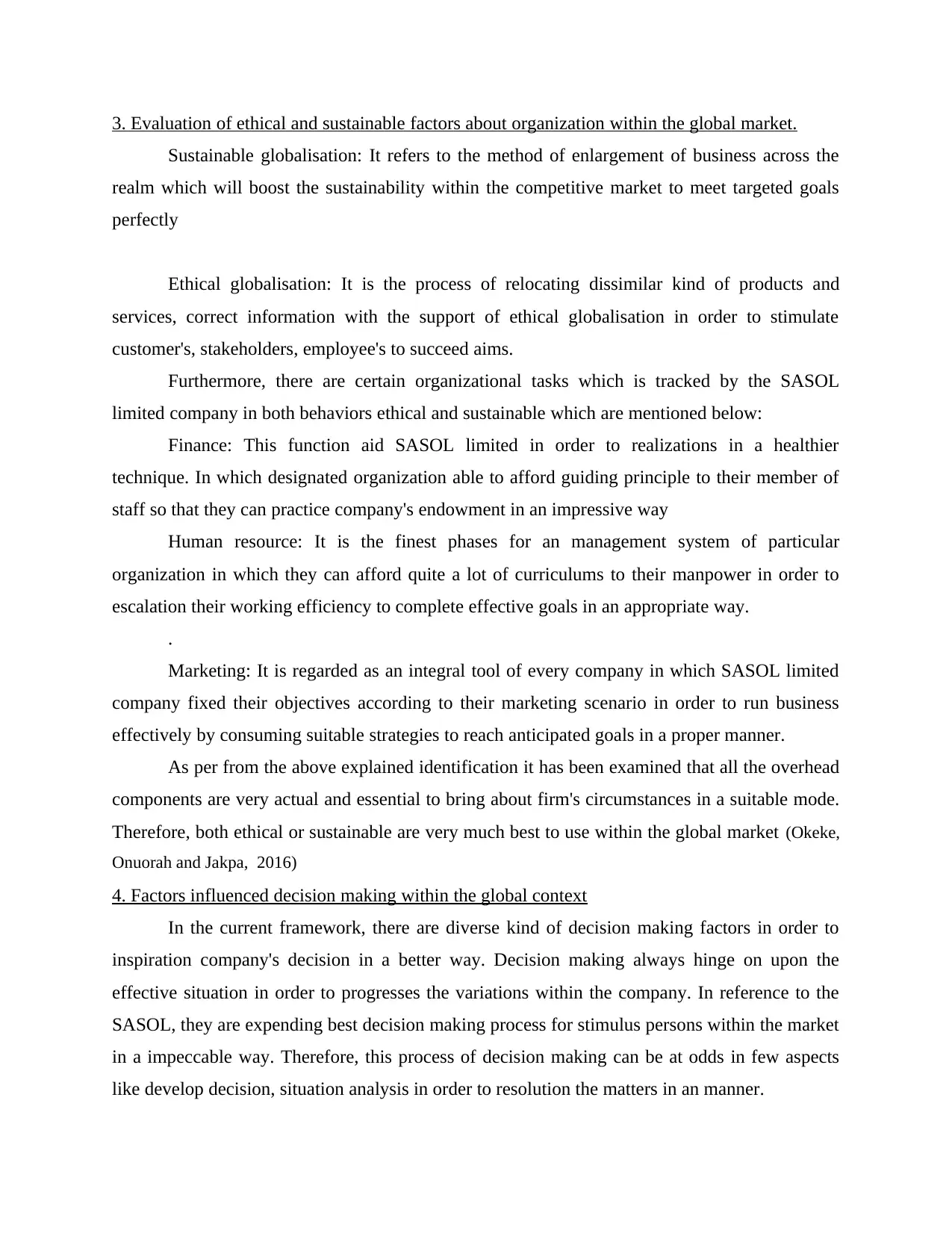
3. Evaluation of ethical and sustainable factors about organization within the global market.
Sustainable globalisation: It refers to the method of enlargement of business across the
realm which will boost the sustainability within the competitive market to meet targeted goals
perfectly
Ethical globalisation: It is the process of relocating dissimilar kind of products and
services, correct information with the support of ethical globalisation in order to stimulate
customer's, stakeholders, employee's to succeed aims.
Furthermore, there are certain organizational tasks which is tracked by the SASOL
limited company in both behaviors ethical and sustainable which are mentioned below:
Finance: This function aid SASOL limited in order to realizations in a healthier
technique. In which designated organization able to afford guiding principle to their member of
staff so that they can practice company's endowment in an impressive way
Human resource: It is the finest phases for an management system of particular
organization in which they can afford quite a lot of curriculums to their manpower in order to
escalation their working efficiency to complete effective goals in an appropriate way.
.
Marketing: It is regarded as an integral tool of every company in which SASOL limited
company fixed their objectives according to their marketing scenario in order to run business
effectively by consuming suitable strategies to reach anticipated goals in a proper manner.
As per from the above explained identification it has been examined that all the overhead
components are very actual and essential to bring about firm's circumstances in a suitable mode.
Therefore, both ethical or sustainable are very much best to use within the global market (Okeke,
Onuorah and Jakpa, 2016)
4. Factors influenced decision making within the global context
In the current framework, there are diverse kind of decision making factors in order to
inspiration company's decision in a better way. Decision making always hinge on upon the
effective situation in order to progresses the variations within the company. In reference to the
SASOL, they are expending best decision making process for stimulus persons within the market
in a impeccable way. Therefore, this process of decision making can be at odds in few aspects
like develop decision, situation analysis in order to resolution the matters in an manner.
Sustainable globalisation: It refers to the method of enlargement of business across the
realm which will boost the sustainability within the competitive market to meet targeted goals
perfectly
Ethical globalisation: It is the process of relocating dissimilar kind of products and
services, correct information with the support of ethical globalisation in order to stimulate
customer's, stakeholders, employee's to succeed aims.
Furthermore, there are certain organizational tasks which is tracked by the SASOL
limited company in both behaviors ethical and sustainable which are mentioned below:
Finance: This function aid SASOL limited in order to realizations in a healthier
technique. In which designated organization able to afford guiding principle to their member of
staff so that they can practice company's endowment in an impressive way
Human resource: It is the finest phases for an management system of particular
organization in which they can afford quite a lot of curriculums to their manpower in order to
escalation their working efficiency to complete effective goals in an appropriate way.
.
Marketing: It is regarded as an integral tool of every company in which SASOL limited
company fixed their objectives according to their marketing scenario in order to run business
effectively by consuming suitable strategies to reach anticipated goals in a proper manner.
As per from the above explained identification it has been examined that all the overhead
components are very actual and essential to bring about firm's circumstances in a suitable mode.
Therefore, both ethical or sustainable are very much best to use within the global market (Okeke,
Onuorah and Jakpa, 2016)
4. Factors influenced decision making within the global context
In the current framework, there are diverse kind of decision making factors in order to
inspiration company's decision in a better way. Decision making always hinge on upon the
effective situation in order to progresses the variations within the company. In reference to the
SASOL, they are expending best decision making process for stimulus persons within the market
in a impeccable way. Therefore, this process of decision making can be at odds in few aspects
like develop decision, situation analysis in order to resolution the matters in an manner.
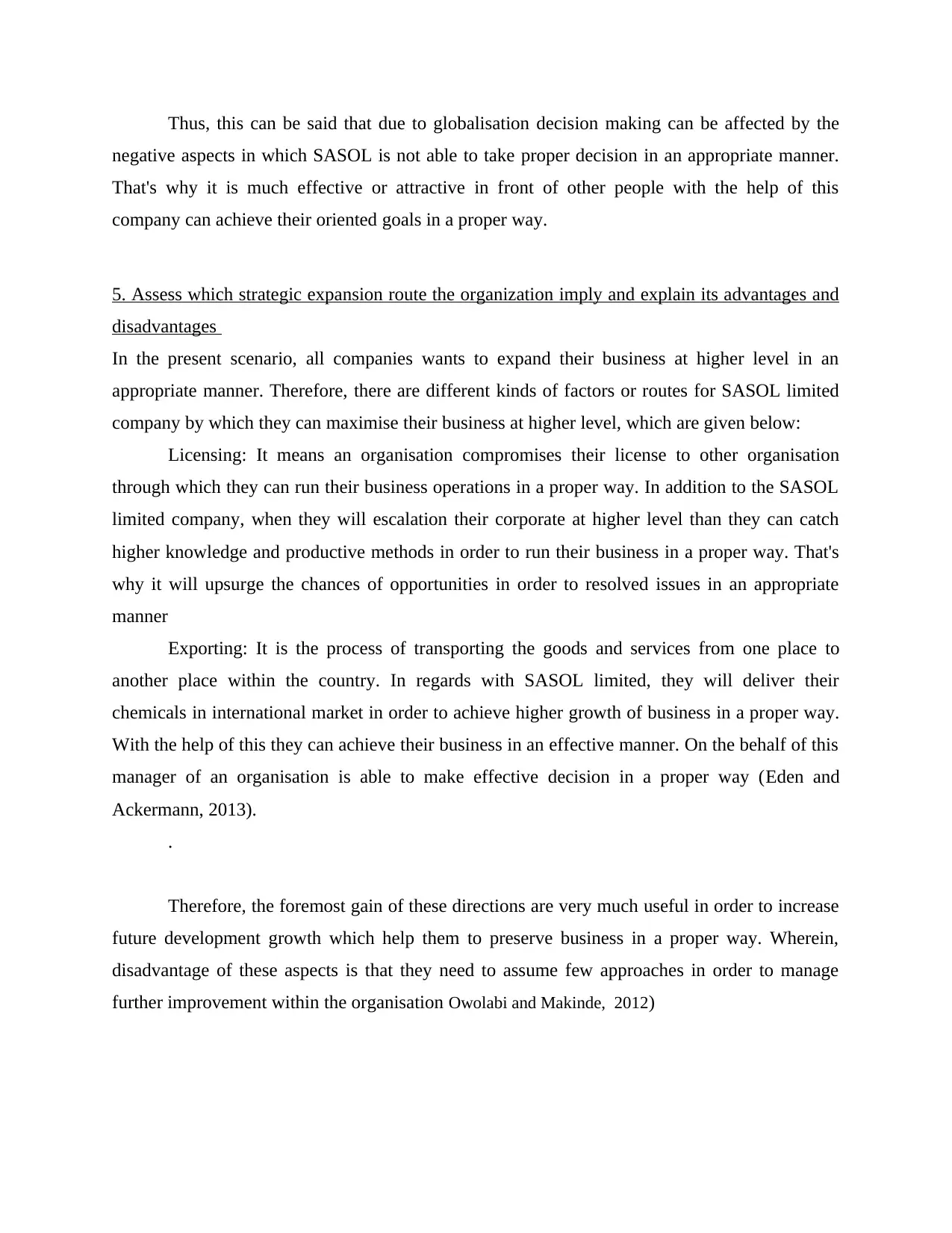
Thus, this can be said that due to globalisation decision making can be affected by the
negative aspects in which SASOL is not able to take proper decision in an appropriate manner.
That's why it is much effective or attractive in front of other people with the help of this
company can achieve their oriented goals in a proper way.
5. Assess which strategic expansion route the organization imply and explain its advantages and
disadvantages
In the present scenario, all companies wants to expand their business at higher level in an
appropriate manner. Therefore, there are different kinds of factors or routes for SASOL limited
company by which they can maximise their business at higher level, which are given below:
Licensing: It means an organisation compromises their license to other organisation
through which they can run their business operations in a proper way. In addition to the SASOL
limited company, when they will escalation their corporate at higher level than they can catch
higher knowledge and productive methods in order to run their business in a proper way. That's
why it will upsurge the chances of opportunities in order to resolved issues in an appropriate
manner
Exporting: It is the process of transporting the goods and services from one place to
another place within the country. In regards with SASOL limited, they will deliver their
chemicals in international market in order to achieve higher growth of business in a proper way.
With the help of this they can achieve their business in an effective manner. On the behalf of this
manager of an organisation is able to make effective decision in a proper way (Eden and
Ackermann, 2013).
.
Therefore, the foremost gain of these directions are very much useful in order to increase
future development growth which help them to preserve business in a proper way. Wherein,
disadvantage of these aspects is that they need to assume few approaches in order to manage
further improvement within the organisation Owolabi and Makinde, 2012)
negative aspects in which SASOL is not able to take proper decision in an appropriate manner.
That's why it is much effective or attractive in front of other people with the help of this
company can achieve their oriented goals in a proper way.
5. Assess which strategic expansion route the organization imply and explain its advantages and
disadvantages
In the present scenario, all companies wants to expand their business at higher level in an
appropriate manner. Therefore, there are different kinds of factors or routes for SASOL limited
company by which they can maximise their business at higher level, which are given below:
Licensing: It means an organisation compromises their license to other organisation
through which they can run their business operations in a proper way. In addition to the SASOL
limited company, when they will escalation their corporate at higher level than they can catch
higher knowledge and productive methods in order to run their business in a proper way. That's
why it will upsurge the chances of opportunities in order to resolved issues in an appropriate
manner
Exporting: It is the process of transporting the goods and services from one place to
another place within the country. In regards with SASOL limited, they will deliver their
chemicals in international market in order to achieve higher growth of business in a proper way.
With the help of this they can achieve their business in an effective manner. On the behalf of this
manager of an organisation is able to make effective decision in a proper way (Eden and
Ackermann, 2013).
.
Therefore, the foremost gain of these directions are very much useful in order to increase
future development growth which help them to preserve business in a proper way. Wherein,
disadvantage of these aspects is that they need to assume few approaches in order to manage
further improvement within the organisation Owolabi and Makinde, 2012)
⊘ This is a preview!⊘
Do you want full access?
Subscribe today to unlock all pages.

Trusted by 1+ million students worldwide
1 out of 15
Related Documents
Your All-in-One AI-Powered Toolkit for Academic Success.
+13062052269
info@desklib.com
Available 24*7 on WhatsApp / Email
![[object Object]](/_next/static/media/star-bottom.7253800d.svg)
Unlock your academic potential
Copyright © 2020–2025 A2Z Services. All Rights Reserved. Developed and managed by ZUCOL.



